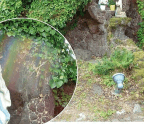
For most of the 18th century, border provinces of what’s now the Netherlands and Belgium were gripped by a reign of terror. Mysterious gangs of armed robbers carried out nocturnal raids and blackmailed the population with brandbrieven (arson letters): if the gangs’ demands for money were not met, your house would be burnt down.
These bendes (gangs) carried out arson attacks and robberies with great violence. Victims were tortured, raped and killed during their operations, with children among those murdered. Gang leader Joseph Kerckhoffs allegedly gave the order during one robbery “in the event of resistance to shoot dead or strike down everyone.”1 Preferred targets were church estates, priests’ homes, farmhouses (preferably isolated ones), inns, monasteries and castles. The gangs had an apparently supernatural ability to cover distances at speed and to melt away before law enforcement could mobilise. The gangs became known as the bokkenrijders – the ‘billy goat riders’ or ‘buck riders’.
Defendants testified in court that gang members used witchcraft – they flew through the air riding on the backs of bokken or billy goats. They were said to have sworn “ungodly oaths” in which they renounced God and pledged themselves to the Devil. Courts heard how in their robberies they used magical “hands of glory”, severed, dried and pickled human hands, to prevent their victims raising the alarm. They were alleged to have gangs of 50 to 100 or more at their disposal, or even small armies.
An estimated 600 bokkenrijders were tried and convicted in three waves over a 75-year period. At least 350 – nearly all men – were executed. But did the bokkenrijder gangs even exist?
ROBBERY IN THE DEVIL’S NAME
The provinces where the bokkenrijders committed “robbery in the Devil’s name” are now roughly Nederlands-Limburg – a province in the southern corner of the Netherlands – and Belgian-Limburg, a border province of Belgium. Some operated in Herzogenrath, now a corner of the federal state of North Rhine Westphalia in Germany.
Back in, the region was the – the Land over the River Meuse ( in Dutch; hence the city of Maastricht). An earlier peace treaty had divvied up this territory between the Republic of the Seven Provinces of the Netherlands and the Spanish Habsburg Empire. The Spanish territories were seceded to Austria from 1714, so in the time of the there were two versions of the Land over the Meuse. There was the “” version of – Dutch territory. The States General, the Parliament of the Republic of the Seven United Provinces of the Netherlands, was officially very Protestant. It didn’t trust its Catholic provinces of the South, so the very Catholic Dutch was under direct rule by a States General-appointed Guardian.




